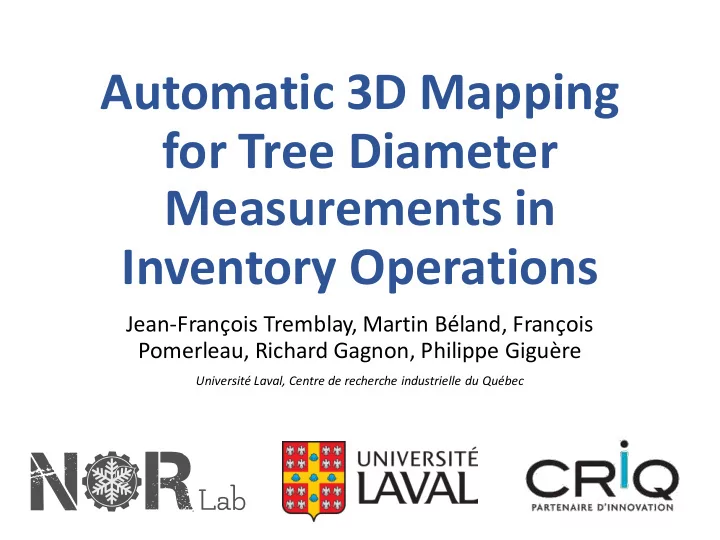

Automatic 3D Mapping for Tree Diameter Measurements in Inventory Operations Jean-François Tremblay, Martin Béland, François Pomerleau, Richard Gagnon, Philippe Giguère Université Laval, Centre de recherche industrielle du Québec
Norlab • Northern Robotics Laboratory • Université Laval’s department of computer science and software engineering • Focused on field robotics in difficult environments • Access to the biggest research forest in the world • Led by François Pomerleau 2/22
Context • Forestry suffers from labor shortages • Automation is part of the solution • Forests: difficult for autonomous robots • We focused on forest inventory: • diameter measurements , height, species • Manual diameter measurement is slow • Use cases: • carbon stock inventory • selective cutting • intelligent forest machines 3/22
Overview • 3D Mapping with Lidar and ICP • Tree segmentation and determination of breast height • Experiments and dataset • Results 4/22
Project Highlights • Large-scale forest 3D mapping experiments • 4 sites, 1.4 ha (14 000 m²) • 11 trajectories • Ground truth diameter for 943 trees • Natural forests, rough terrain, GPS denied • In-depth comparison of diameter extraction algorithms from point clouds Authors Year Number of trees RMSE McDaniel et al. 2012 113 13.1 cm Tsubouchi et al. 2014 6 2.1 cm Seki et al. 2017 7 1.6 cm 5/22
Lidar TLS MLS (Our data) Resolution ALS Speed 6/22
ICP Mapping • Study how ICP mapping performs in forests • Software based on ethz_icp_mapper • No real-time operation: focus on map quality 7/22
Where to Measure the Diameter? (1) • Manual segmentation bounding boxes • Avoids bias by testing only on easily detectable trees • Build a digital terrain model h ( x, y ) • Breast height: 1.3 meters • Choose points in the bounding boxes according to their height z – h ( x, y ) • Fit cylinder to the selected points 8/22
Where to measure the diameter? (2) Full map 9/22
Where to measure the diameter? (3) Digital terrain model 10/22
Where to measure the diameter? (4) Tree segmentation 11/22
Where to measure the diameter? (5) Final point selection 12/22
Cylinder Fitting: 3 Approaches • Linear least squares fitting, using normals • Non-linear least squares fitting, with and without normals • Mean and median of fittings at different heights h 13/22
Experiments • Forêt Montmorency – 3 sites, 7 trajectories • Université Laval Campus – 1 site, 4 trajectories • 943 trees, with 588 > 10 cm diameter • Total of 1458 observations of trees > 10 cm, from different trajectories 14/22
Test sites (1) Young Mixed 15/22
Test sites (2) Mature Maple 16/22
Ground-truth data • Varied in: • Species • Age • Density • Terrain • Leaves on/off Varied in: i ) Species ii ) Age iii ) Density iv )Terrain v ) Leaves on/off 17/22
Mapping results 18/22
Diameter results (1) • Best performing site: Mature with 2.04 cm of RMSE • 3.45 cm for whole dataset of 1,458 tree observations • Negative bias for Maple (-3 cm), caused by bark texture 19/22
Diameter results (2) • Mean of multiple cylinders does not help, median does • Leaves have a negative effect if tree is far 20/22
Conclusion • ICP mapping works in boreal forests • Accurate enough to: • produce consistent maps as large as one ha • extract diameters with accuracy as good as 2 cm • Best for diameter estimation: • initial estimate with normals + least squares + median of multiple fits • stay within 10 m of trees: closer is better 21/22
Future work • Part of a bigger project for automation in forestry (P. Giguère) • Integrating work for species identification [1] • Identify grasp locations in point clouds • Real time mapping • Continuous-time trajectory Credits: Komatsu [1] Carpentier et al., Tree Species Identification from Bark 22/22 Images Using Convolutional Neural Networks , IROS, 2018
Recommend
More recommend